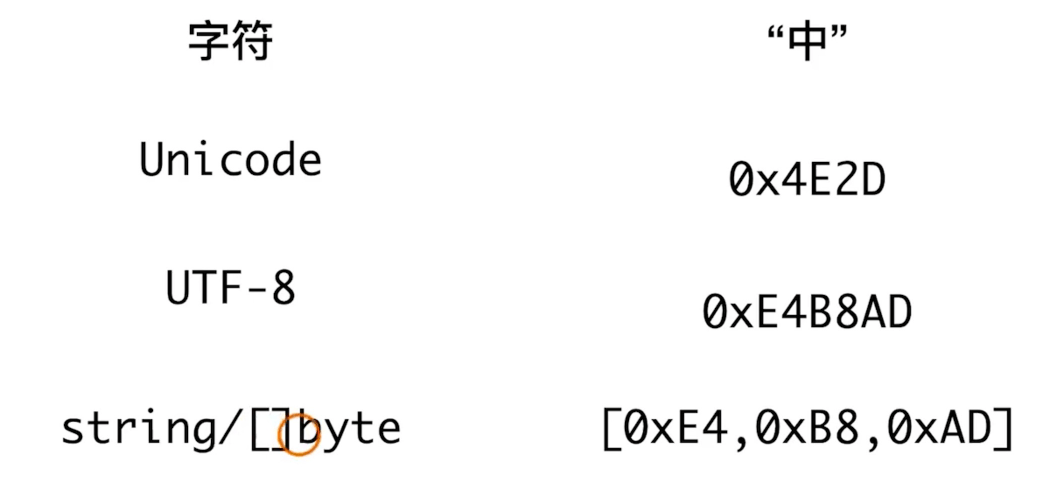与其他编程语言的差异
- string 是数据类型,不是指针或者引用类型,默认初始化的空值是空字符串,不是
nil。 - string 是只读的 byte slice
- string 的 byte 数组可以存放任何数据,len 求byte的长度
字符串类型的内部结构定义
对于标准编译器,字符串类型的内部结构声明如下:
type _string struct {elements *byte // 引用着底层的字节len int // 字符串中的字节数}
从这个声明来看,可以将一个字符串的内部定义看作为一个字节序列。 事实上,我们确实可以把一个字符串看作是一个元素类型为byte的(且元素不可修改的)切片。
unicode 和 utf8
Unicode 是一种编码(code point),UTF8是unicode的存储实现(转化为字节序列的规则),详情参考字符编码笔记:ASCII,Unicode 和 UTF-8。

在UTF-8编码中,一个码点值可能由1到4个字节组成。
- 英语码点值(均对应一个英语字符)均由一个字节组成
- 中文字符(均对应一个中文字符)均由三个字节组成
- emoji 均由4个字节组成
示例,字母,中文,emoji 的 unicode 和 utf8 编码
// 英文字符strEn := "a"fmt.Printf("%s bytes len is %d\n", strEn, len(strEn)) // a bytes len is 1fmt.Printf("%s chars len is %d\n", strEn, len([]rune(strEn))) // a chars len is 1fmt.Printf("%s chars len is %d\n", strEn, utf8.RuneCountInString(strEn)) // a chars len is 1// unicode 编码fmt.Printf("%s unicode is %x\n", strEn, []rune(strEn)[0]) // a unicode is 61// 存储形式fmt.Printf("%s utf8 is %x\n", strEn, strEn) // a utf8 is 61// 中文字符strZh := "中"fmt.Printf("%s bytes len is %d\n", strZh, len(strZh)) // 中 bytes len is 3fmt.Printf("%s chars len is %d\n", strZh, len([]rune(strZh))) // 中 chars len is 1fmt.Printf("%s chars len is %d\n", strZh, utf8.RuneCountInString(strZh)) // 中 chars len is 1// unicode 编码fmt.Printf("%s unicode is %x\n", strZh, []rune(strZh)[0]) // 中 unicode is 4e2d// 存储形式fmt.Printf("%s utf8 is %x\n", strZh, strZh) // 中 utf8 is e4b8ad// 表情emoji := "🌈"fmt.Printf("%s bytes len is %d\n", emoji, len(emoji)) // 🌈 bytes len is 4fmt.Printf("%s chars len is %d\n", emoji, len([]rune(emoji))) // 🌈 chars len is 1fmt.Printf("%s chars len is %d\n", emoji, utf8.RuneCountInString(emoji)) // 🌈 chars len is 1// unicode 编码fmt.Printf("%s unicode is %x\n", emoji, []rune(emoji)[0]) // 🌈 unicode is 1f308// 存储形式fmt.Printf("%s utf8 is %x\n", emoji, emoji) // 🌈 utf8 is f09f8c88
字符串处理
- 包含
- func Contains(s, substr string) bool 是否包含子字符串
- func ContainsAny(s, chars string) bool 包含任意子串
- 切割
- func Fields(s string) []string 按空白切割
- func Split(s, sep string) []string 按指定内容切割
- func SplitAfter(s, sep string) []string
- 开头结尾判断
- func HasPrefix(s, prefix string) bool 开头
- func HasSuffix(s, suffix string) bool 结尾
- 替换
- func Replace(s, old, new string, n int) string 替换指定长度的内容
- func ReplaceAll(s, old, new string) string 替换所有的匹配的内容
- 删除指定字符
- func Trim(s string, cutset string) string 删除指定字符
- func TrimSpace(s string) string 删除两端空白字符
- func TrimLeft(s string, cutset string) string
- func TrimRight(s string, cutset string) string
- func TrimPrefix(s, prefix string) string
- func TrimSuffix(s, suffix string) string
示例,字符串分割连接
str := "hello, world!"for _, v := range strings.Split(str, ",") {fmt.Println(v)}// outhelloworld!
字符串转化
- func Atoi(s string) (int, error)
- func Itoa(i int) string
- func ParseBool(str string) (bool, error)
- func ParseFloat(s string, bitSize int) (float64, error)
- func ParseInt(s string, base int, bitSize int) (i int64, err error)
示例,字符串/整数相互转化
s := strconv.Itoa(10)fmt.Println("str" + s)i, err := strconv.Atoi("10")if err != nil {fmt.Println("convert failed")os.Exit(1)}fmt.Println(i)

